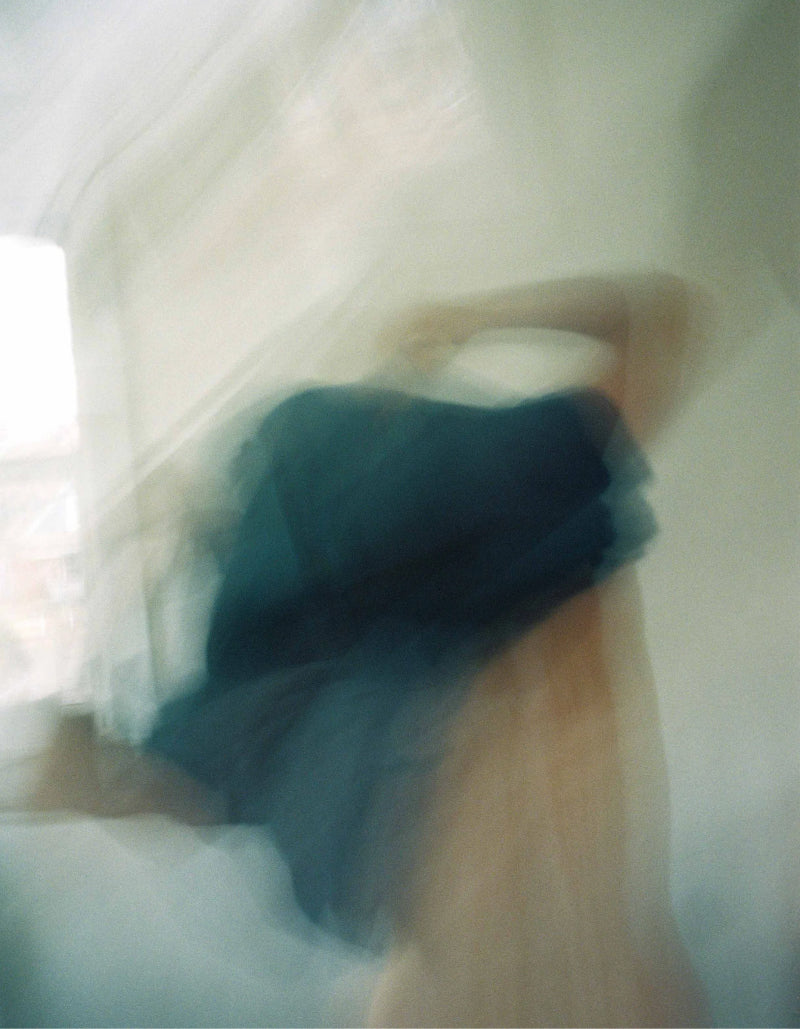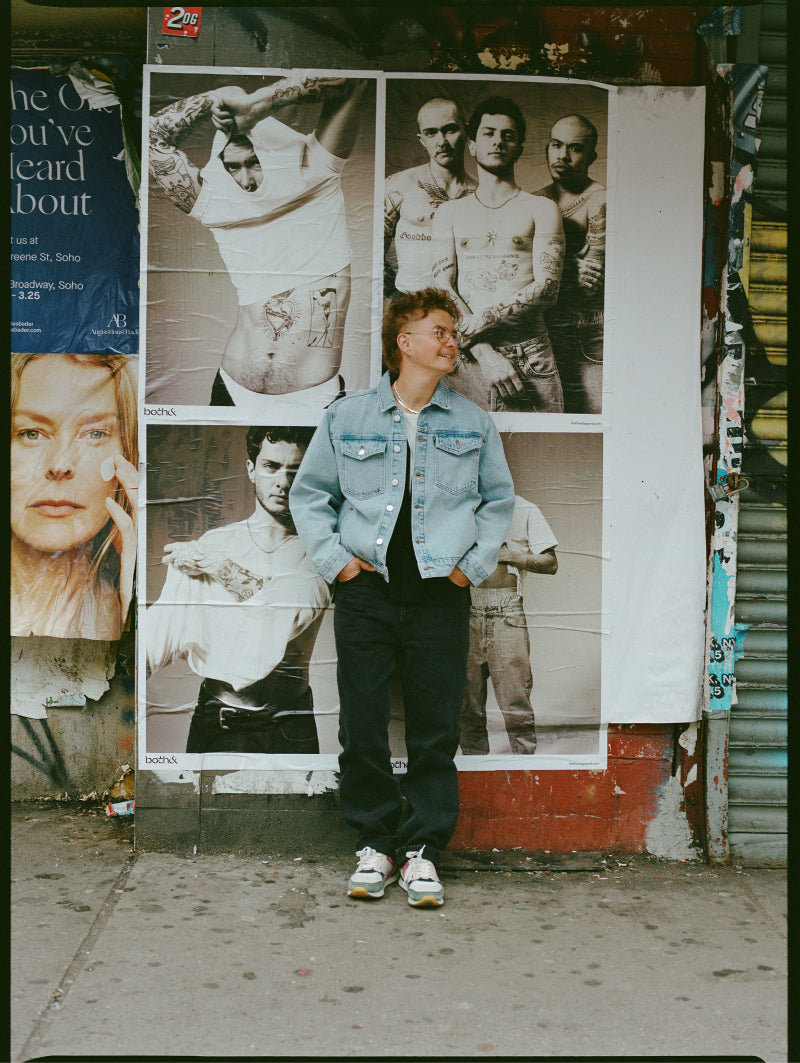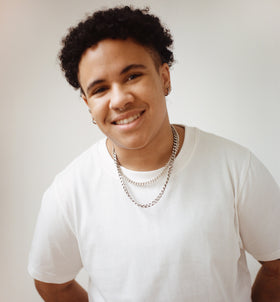
Feb 23, 2024
Coming Out as Trans
Finnegan Shepard Founder of Both&
I never identified with the phrase ‘coming out.’ It’s interesting to me, as a 31 year old, to now hear how younger generations are actively pushing against it or resisting it as a concept. But when I was growing up, the phrase was ubiquitous in the queer community. Everyone has their coming out story–sometimes multiple ‘coming outs.’ Certainly there can be power in these stories. Coming out is, in a sense, a boundary. It’s a boundary that we draw in order to feel more accurately seen and for those around us to treat us the way we want to be treated (hopefully). Ideally, we would live in a world where this doesn’t need to happen, but unfortunately, historically, that has not been the case for LGTBQIA folks.
In this personal essay, I am going to tell the story of my journey, not as a clean before/after, but as a continually evolving process by which I felt growing alignment between how I saw myself and how the world saw me. My hope is that the narrative aspect can be of some help to others–I know for myself, one of the most impactful things during my journey was to engage with other people’s experiences, to realize that the whole range of my emotions (from fear and insecurity and doubt to elation and joy and excitement) didn’t make me unusual, but in fact were perfectly normal.
Trying Myself On
One of the troubling aspects of the political debate around trans rights and access to gender affirming care today is the way in which the trans community has had to force our legitimacy into a binary box: we were miserable before, now we are perfectly happy. We knew since the moment we were born. We never have regrets, we always know exactly who we are. While this certainty and clarity is true for some trans people, for most of us, we need to go through a long exploratory journey of figuring out who we are, and what ‘fits.’
This is not unique to trans people. Every person on earth ‘tries themself on’ in myriad iterations. We try to fit in with certain groups, we pick up hobbies, styles, manners of speaking. We are scouting out our identity. This is natural.

For myself personally, there were certain things that I was completely clear on:
- I only wanted to wear boys clothing
- I didn’t want long hair
- Girls could give me butterflies, and boys couldn’t
- I thought I was the reincarnation of King Arthur
And other things I wasn’t clear on at all:
- What defines a boy or a girl
- Do I want to fit into either category
- Does my name and she/her pronouns feel wrong? (for many many years, they didn’t)
The acuteness of these questions also varied over my lifetime. In elementary school, I found gender odd, more than anything else. I was lucky enough to grow up in a family that let me wear boys' clothing, play with boys, etc. and so I didn’t feel segregated out from dynamics or ways of self expression that were important to me. As a result, it wasn’t so much that I identified as female or male so much as the fact that my body felt relatively arbitrary–a place I was inhabiting rather than identifying with.
This changed when puberty hit, and my body began to evolve. Suddenly, the stakes felt a lot higher, and I felt a lot less in control. For the next decade and a half, I would be in a phase of very actively ‘trying myself on.’ I changed my style and my haircut. I lifted weights. I observed how social dynamics shifted based on how I carried myself, how loud or quiet my voice was, whether I was dating someone or not, and how that person was perceived.
Between the ages of twelve to twenty five, I had one ‘soft’ coming out as a I call it, but for the most part I was dedicated to the notion that I would somehow extract myself from gender entirely, make it something that couldn’t touch me or impact my life. In some ways I achieved this, and in others I didn’t.
Extracting Myself from Gender
Around fourteen or so, my mother, with all of the right intentions, took us to a local theater show, being put on by, in my words, “some ancient lesbians.” I remember very little of the show, only that my mother, again, with the best of intentions, tried to sign me up for the youth theater group they ran. I was mortified. At that age, my number one priority was to resist the label of ‘lesbian’ that was so easily put on me. This had nothing to do with a dislike or aversion to lesbians themselves, but to my gut level terror of being mis-seen. It was the language and framework of understanding that existed at the time: I was born female, presented in a masculine way, and was attracted to women. That made me a lesbian, right? But my answer was a resounding no. No, that’s not who I am.

On the drive home, my mother tried to talk to me about it. All I could manage to say, through the shame and fear and lack of language, was something along the lines of, “I like girls, but not as a girl.” My mother didn’t know what to say to that. I could see that she was trying hard to understand, but that she too was operating without the framework.
Years passed. I didn’t socially or medically transition. Instead, I endeavoured to build a social world around me in which people thought of me as ‘just Becca.’ In fact, multiple friends reported to me that they didn’t see me as a girl or a boy, just as me. In today’s world, this experience would align with many gender queer or nonbinary people’s experience. At the time, I didn’t even know the word nonbinary.
From Extraction to Definition
When I was in my mid-twenties, I met someone who immediately saw me as Finn. Her putting a name to it, and gently pushing me to discuss the topic with her, created a domino effect in me. For years, I had held the possibility of transition at arms length–I didn’t even let myself think about it. Suddenly, here was someone who I loved and who loved me (and importantly, was attracted to me), pointing to this off-limits idea and saying: hey look, let’s talk about this. It was wildly intoxicating and utterly terrifying.
I began to play with the idea. The name Finn was a no-brainer to me. It had always been lurking in the back of my consciousness. I asked her to start using it, but only when we were in private together. Then I asked her to use he/him pronouns. I told my sister, and a few old friends. We travelled back home for Spring break, and I told my parents, who all in all took it very well. That spring, my group of friends (who I was in a graduate course with at the time), did two wonderful things. First, at a party, which I suppose would be the closest to a specific coming out moment in my journey as I have, a conversation with two friends, which grew into three, four, five, a whole group, led to an impromptu ‘baptism’ on the balcony, with a friend pouring a glass of tap water over my head while everyone chanted “Finn, Finn, Finn!”. Secondly, these friends had the grace (and bandwidth) to switch between he/him when we were outside of class, and continue using she/her in class, which was a space I hadn’t yet ‘come out’ in. People are wonderful.
For the first nine months, I was certain I wanted top surgery, but didn’t think I wanted to go on hormones. That all changed after one fateful day, when I was working out at the gym and between sets browsed through an Instagram account that showcased thousands of trans’ mens’ transitions, with a before photo and an after/later photo. Up until that point, I hadn’t been able to visualize transition. I knew very few trans people as reference points. Being able to see the diversity of trans men and their forms of self expression shifted something in me. I knew I wanted that.
Being able to see the diversity of trans men and their forms of self expression shifted something in me. I knew I wanted that.
With that realization, there was of course a whole new wave of fears and fears: how would testosterone do with my body, how would I handle the needles, how quickly would change come, and in what form, and what would that be like in the world–in bathrooms, in airports, etc. Then there were the doubts about the doubts. If I had any hesitations, was I doing the right thing?
I remember waking in the night in cold sweats, feeling as though the train had left the station, and there was a mass and velocity behind it I couldn’t stop. I wanted to go where I was going, but I was also terrified of not being in control.
One of the great blessings of my journey was to be surrounded by wise people who validated my fears and doubts. Instead of pointing to them as reasons not to transition, or reasons that I wasn’t “really trans,” they instead affirmed them as a natural and healthy part of transition. “It would be insane to go through this and have no doubts,” one of them aptly said. Years later, it is abundantly clear to me that they were right, and I try to pass along this torch of grace to anyone who needs to hear it.
Trans-ness ‘after’ Transition
It is not clear to me that there is a clean boundary of transition. At what point have I transitioned, i.e., at what point is in the past tense? On the one hand, the changes to my body have slowed considerably. In the first year, when my voice dropped, muscles started blooming on my shoulders and arms, and a Justin Bieber-style moustache appeared, it was easy to feel like I was in the midst of something. Now, four years in, my body still changes, but in a way that feels like the natural change that occurs to all bodies over time. We are, after all, never static in our physicality.
What is most extraordinary to me is how little headspace being trans now takes up. I don’t think I realized how much of my bandwidth and energy was going into the vacuum of identity pre-transition. One way I like to talk about it is the analogy of doing compound lifts (squats, deadlifts, bench press) without the right technique, and therefore relying on all the little muscles to make up for the lack of exertion from the major muscle groups. Identity pre-transition felt like that, like a racing to compensate. Now, it feels like the major muscle groups are activated, and that I am the same me in the world, but it’s just easy, effortless. Transness comes up frequently in my day to day, not because of my personal identity, but because of the fact that I am the founder of Both&. This makes the visibility of my identity come to the fore in almost every conversation with new people (because everyone asks what you do, which inevitably leads to a ‘coming out’). It also enables me to talk about transness from a different angle than the way it is usually discussed in mainstream media, which I see as important work to be done.
But day to day, I do not think about the fact that I am trans. I think about what I want for breakfast, and whether my partner and I should go on a hike this weekend, and what shoes I want to pair with my outfit. In other words, I have the privilege of simply being human, or feeling right in my body (not because I love every single aspect of it, but because it feels accurate), and of being empowered to get on with life. At the end of the day, that is the miracle we should all count our blessings for.




